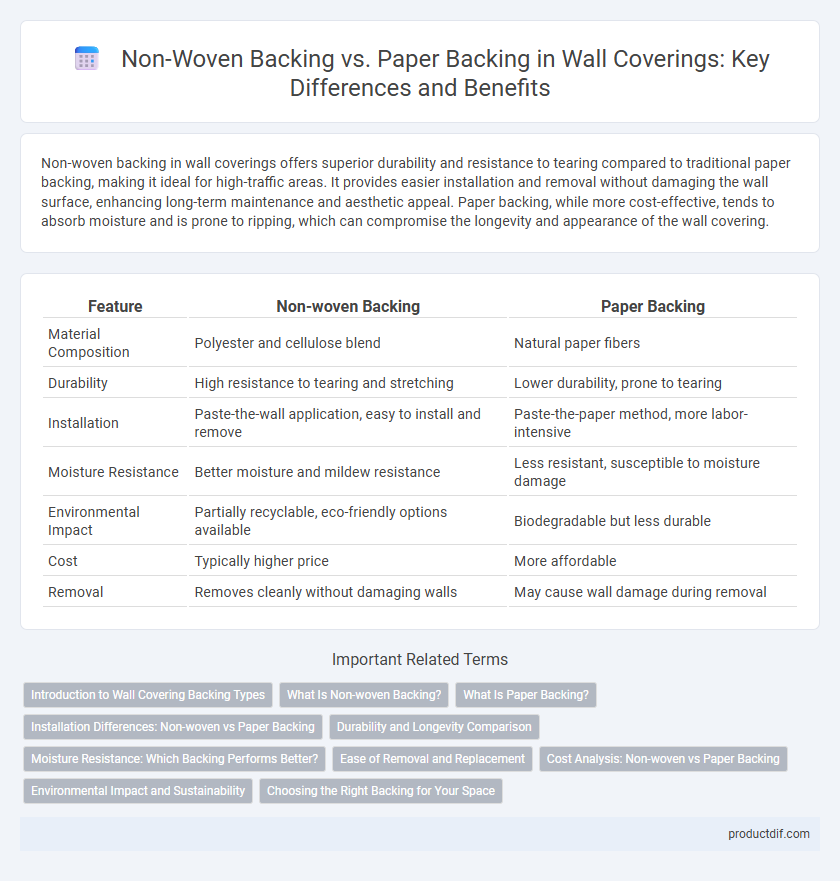Non-woven backing in wall coverings offers superior durability and resistance to tearing compared to traditional paper backing, making it ideal for high-traffic areas. It provides easier installation and removal without damaging the wall surface, enhancing long-term maintenance and aesthetic appeal. Paper backing, while more cost-effective, tends to absorb moisture and is prone to ripping, which can compromise the longevity and appearance of the wall covering.
Table of Comparison
| Feature | Non-woven Backing | Paper Backing |
|---|---|---|
| Material Composition | Polyester and cellulose blend | Natural paper fibers |
| Durability | High resistance to tearing and stretching | Lower durability, prone to tearing |
| Installation | Paste-the-wall application, easy to install and remove | Paste-the-paper method, more labor-intensive |
| Moisture Resistance | Better moisture and mildew resistance | Less resistant, susceptible to moisture damage |
| Environmental Impact | Partially recyclable, eco-friendly options available | Biodegradable but less durable |
| Cost | Typically higher price | More affordable |
| Removal | Removes cleanly without damaging walls | May cause wall damage during removal |
Introduction to Wall Covering Backing Types
Non-woven backing in wall coverings offers superior durability and tear resistance compared to traditional paper backing, making installation easier and faster with minimal risk of damage. Paper backing, while more affordable and widely available, tends to be less resilient, often requiring careful handling to prevent ripping or stretching. Choosing between non-woven and paper backing depends on the desired longevity and installation conditions for the wall covering project.
What Is Non-woven Backing?
Non-woven backing in wall coverings consists of a blend of natural and synthetic fibers bonded together for enhanced durability and tear resistance. This type of backing offers superior stability, making it easier to install and remove compared to traditional paper backing. Non-woven wall coverings are breathable and resistant to moisture, reducing issues like bubbling and peeling over time.
What Is Paper Backing?
Paper backing in wall coverings refers to a traditional layer of paper that provides support and durability to wallpaper. It offers a smooth surface for printing detailed designs and helps with easy application and removal from walls. Unlike non-woven backing, paper backing is less resistant to tearing and moisture, making it suitable for low-traffic or dry interior spaces.
Installation Differences: Non-woven vs Paper Backing
Non-woven backing wallpapers offer a smoother installation process since they can be applied using paste-the-wall techniques, allowing for easier repositioning and reduced drying time. Paper-backed wallpapers require pasting the paper itself, making alignment more challenging and increasing the risk of tearing or bubbling during application. The enhanced durability and breathability of non-woven backing contribute to fewer installation errors compared to traditional paper backing.
Durability and Longevity Comparison
Non-woven backing offers superior durability and longevity compared to paper backing due to its synthetic fiber composition, which resists tearing, stretching, and moisture damage. Wall coverings with non-woven backing maintain structural integrity and appearance for years, making them ideal for high-traffic or humid areas. Paper-backed wallpapers tend to be more prone to damage from humidity and wear, often requiring more frequent replacement or repair.
Moisture Resistance: Which Backing Performs Better?
Non-woven backing outperforms paper backing in moisture resistance due to its synthetic fibers that repel water and prevent mold growth, making it ideal for humid environments like bathrooms and kitchens. Paper backing tends to absorb moisture, leading to potential bubbling, peeling, and reduced wallpaper lifespan. Choosing non-woven backing ensures enhanced durability and better adhesion in moisture-prone areas.
Ease of Removal and Replacement
Non-woven backing in wall coverings offers superior ease of removal due to its tear-resistant and flexible fibers, minimizing wall damage and residue during replacement. Paper-backed wallpapers tend to be more fragile, increasing the risk of tearing and leaving adhesive residue that complicates removal. Choosing non-woven backing enhances efficiency in redecorating by simplifying the stripping process and preserving wall integrity.
Cost Analysis: Non-woven vs Paper Backing
Non-woven backing wallcoverings generally cost more upfront than paper-backed options due to higher material quality and durability. Despite the higher initial expense, non-woven backing often results in lower long-term costs by reducing installation time and enhancing tear resistance, minimizing replacement frequency. Paper-backed wallcoverings remain a budget-friendly choice but may incur additional expenses over time due to increased susceptibility to damage and complex removal processes.
Environmental Impact and Sustainability
Non-woven backing offers superior environmental benefits compared to paper backing due to its recyclable composition and reduced resource consumption during manufacturing. Paper backing, while biodegradable, often involves intensive water and energy use, contributing to higher environmental footprints. Selecting non-woven wall coverings supports sustainability goals by enhancing durability and enabling easier disposal through recycling programs.
Choosing the Right Backing for Your Space
Non-woven backing offers superior durability and moisture resistance, making it ideal for high-traffic or humid areas such as kitchens and bathrooms. Paper backing is more affordable and easier to install, suitable for low-traffic rooms or temporary decor changes. Selecting the right backing depends on the room's moisture levels, durability needs, and budget constraints to ensure long-lasting, visually appealing wall coverings.
Non-woven Backing vs Paper Backing Infographic

 productdif.com
productdif.com